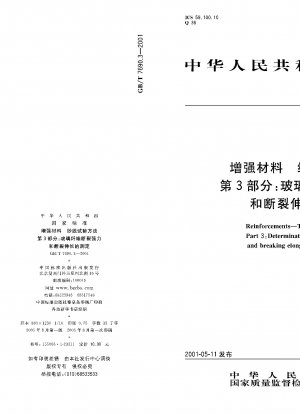GB/T 7690.3-2001
Reinforcements--Test method for yarns Part 3: Determination of breaking force and breaking elongation for glass fibre (English Version)
- Standard No.
- GB/T 7690.3-2001
- Language
- Chinese, Available in English version
- Release Date
- 2001
- Published By
- General Administration of Quality Supervision, Inspection and Quarantine of the People‘s Republic of China
- Status
- 2014-08
- Replace By
- GB/T 7690.3-2013
- Latest
- GB/T 7690.3-2013
- Scope
- 1.1 This standard specifies the method for measuring the breaking strength and breaking elongation of glass fiber yarn provided in package form. 1.2 This standard is applicable to various types of glass fiber yarns (single yarn, ply yarn, cable, raw silk, absolute roving, roving, etc.). Suitable for glass fiber single yarn, plied yarn and cable with diameter less than 2mm or linear density less than 2000tex taken from the package. If the measurement conditions provided can be accepted by all parties concerned about the test results, it can also be used for the measurement of yarns with a diameter greater than 2mm or a linear density greater than 2000tex. 1.3 This method is not applicable to glass fiber yarns whose elongation exceeds 0.5% under the conditions of standard environmental humidity adjustment and 5mN/tex pretension. Such yarns may be tested with a lower pretension (such as 2.5mN/tex or 1mN/tex) under the conditions agreed by the parties concerned. This situation mainly occurs in staple fiber yarns. Note: 1. This method can also be used to determine beam yarn or yarn taken from fabric, but the test result is only for status indication. 2. This method is mainly used for the determination of material properties and quality control. Fiber-to-fiber friction and factors such as uneven tension (drapability) will increase the dispersion of test results, resulting in low test values. This necessarily affects the exact correlation between yarn properties and final application results. 3. Although this standard provides the possibility to determine the elongation at break, this method is not recommended. Indeed, the correct way to measure elongation at break is only with an extensometer and not based on the displacement of a moving fixture beam. But on the other hand, experiments have shown that the use of extensometers to measure is very accurate, but it is easy to damage the sample.
GB/T 7690.3-2001 history
- 2013 GB/T 7690.3-2013 Reinforcements.Test method for yarns.Part 3:Determination of breaking force and breaking elongation for glass fibre
- 2001 GB/T 7690.3-2001 Reinforcements--Test method for yarns Part 3: Determination of breaking force and breaking elongation for glass fibre

GB/T 7690.3-2001 -All Parts
GB/T 7690.1-2013 Reinforcements.Test method for yarns.Part 1:Determination of linear density
GB/T 7690.2-2013 Reinforcements.Test method for yarns.Part 2:Determination of twist
GB/T 7690.3-2013 Reinforcements.Test method for yarns.Part 3:Determination of breaking force and breaking elongation for glass fibre
GB/T 7690.4-2013 Reinforcements.Test method for yarns.Part 4:Determination of stiffness
GB/T 7690.5-2013 Reinforcements.Test method for yarns.Part 5:Determination of fiber diameter for glass fiber
GB/T 7690.6-2013 Reinforcements.Test method for yarns.Part 6:Determination of twist balance index